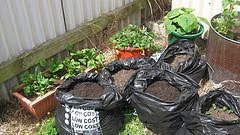
This is my second post about my involvement with the online course '
Facilitating Online' delivered by
Otago Polytechnic. In my post '
"Facilitating Online" 2009: Evaluation' I have talked about the students' feedback and the changes I recommend the course for the future. In this post I want to reflect on my own personal experiences of being a facilitator and teacher in this course.
Separating facilitation and assessingI was first asked by
Leigh Blackall to facilitate this course back in July 2009. The idea was for me to facilitate and he would carry out the more formal 'teacher' tasks ie marking assessment. This separating of roles was an attempt to manage the tension that arises between being a teacher and facilitator. Leigh has felt for some time that it is better to separate the roles and to see what happens when the person who has the power of marking assessment is different to the person who is guiding students' way to learning. To find out more about Leigh's thoughts on this topic, please go to his post "
To facilitate or teach".
What is a facilitator?As the course facilitator it was my role to make sure everything was organised - people knew what they were doing and had access to all the information and resources. It was my job to organise the live online sessions and keep up the
course blog with posts that summarised what had been happening. I did not have to develop any of the materials - they had already been developed by Leigh and were available on the
course wiki.
Maintaining my roleI did struggle at times with maintaining a 'facilitation only' role. I may be wrong, but I felt it was not my role to introduce new material and I also believed it was important for me to stay neutral in discussions. However, I found this was very difficult to do, especially as many of the learners were new to the topics we were looking at. So I found myself taking a lead at times because I was the 'expert' at the time. For example, we got into discussions about Twitter so I wrote up a couple of blog posts about the use of
Twitter, and use of
Twitter for teaching and learning.
Giving feedbackI also found it difficult to know
what feedback to give students as a facilitator, rather than a teacher. I didn't like to give feedback on their performance as such because I felt that was the teacher's role, especially relating to their
individual blogs which was an
assessment requirement. So I endeavoured to ask questions that hopefully would get students thinking further. But I felt the problem with that was that the students were going through the course a little blind because they did not know how they were progressing in terms of assessment.
What happened when I took on dual roles of teaching and facilitationHalf way through the course circumstances changed and I became facilitator and teacher. This had several effects. On the one hand I felt a lot more relaxed, feeling that I didn't need to worry so much about what I was doing...what hat I was wearing.
On the down side, I felt a change in dynamics between myself and the students when it came to assessment. I felt I had changed from being fellow traveller down the road of learning to being a critic. This brought me back to the question I am often angsting about when I am involved with assessment in courses such as this:
who am I to put a value on a person's learning?Holistic assessmentThe positive aspect to mixing teaching/assessment and facilitation roles is that I had a much better sense of who the students were and their progress through the course when assessing them than Leigh would have had if he had been the assessor only. I felt that this allowed me to take a far more holistic approach to assessment - I knew what the students' backgrounds were, how they had grown over the course, what problems they faced and overcome. I also knew how the course had unfolded over the weeks - what its strengths and weaknesses were - what students were clear about and the areas that students had not explored adequately. All these things I was able to take into consideration when I was marking their assessment.
What I learnedI am not at all sure if I am making any sense of this, but I am not convinced the model of facilitating a course separately from assessment works well. This may be because of the way I defined what a facilitator does. What do you think - how would you define the facilitator's role in the context of an education course?
I understand the issue of power and control, and how that can affect the students' learning experience. I also agree that my role is not to tell students what to do but rather guide,
steward or
curate them to their own understanding and creation of learning. At the same time, there will be times when I am the expert and students will learn from my 'telling'.
I don't know if the discussion should be about the effect of the roles of the teacher and facilitator on learning, but rather the role of assessment in learning? What do you think? Do you think it matters what roles people take in a course, or is the teaching style and personality that affects learning?
What about next year?As for what I would recommend for next year? I'm not sure. I do think it is good to have more than one person involved in a course like 'Facilitating Online' so you get a mix of teaching and facilitating styles and approaches. And the issue of the power a teacher has over students with assessment is diluted and moderated. I'd love to hear what you think and your experiences in open online courses.
Image: 'Teaching Math or Something' foundphotoslj
http://www.flickr.com/photos/82312837@N00/466713478

















